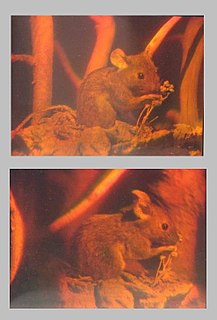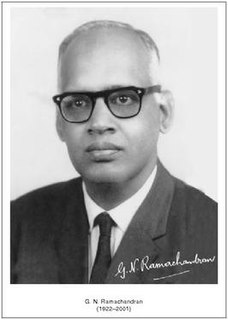Related Research Articles

Diffraction refers to various phenomena that occur when a wave encounters an obstacle or opening. It is defined as the interference or bending of waves around the corners of an obstacle or through an aperture into the region of geometrical shadow of the obstacle/aperture. The diffracting object or aperture effectively becomes a secondary source of the propagating wave. Italian scientist Francesco Maria Grimaldi coined the word diffraction and was the first to record accurate observations of the phenomenon in 1660.

Microscopy is the technical field of using microscopes to view objects and areas of objects that cannot be seen with the naked eye. There are three well-known branches of microscopy: optical, electron, and scanning probe microscopy, along with the emerging field of X-ray microscopy.

Holography is a technique that enables a wavefront to be recorded and later re-constructed. Holography is best known as a method of generating three-dimensional images, but it also has a wide range of other applications. In principle, it is possible to make a hologram for any type of wave.

Electron diffraction is a phenomenon of electron beam bending around atomic structures. This behaviour typical for waves is applicable to electrons due to the wave–particle duality stating that electrons behave as both, particles and waves. Since the diffracted beams interfere, they generate diffraction patterns widely used for analysis of the objects which caused the diffraction. Therefore, electron diffraction can also refer to derived experimental techniques used for material characterization. This technique is similar to X-ray and neutron diffraction.

The resolution of an optical imaging system – a microscope, telescope, or camera – can be limited by factors such as imperfections in the lenses or misalignment. However, there is a principal limit to the resolution of any optical system, due to the physics of diffraction. An optical system with resolution performance at the instrument's theoretical limit is said to be diffraction-limited.

Gopalasamudram Narayanan Ramachandran, or G.N. Ramachandran, FRS was an Indian physicist who was known for his work that led to his creation of the Ramachandran plot for understanding peptide structure. He was the first to propose a triple-helical model for the structure of collagen. He subsequently went on to make other major contributions in biology and physics.

Confocal microscopy, most frequently confocal laser scanning microscopy (CLSM) or laser confocal scanning microscopy (LCSM), is an optical imaging technique for increasing optical resolution and contrast of a micrograph by means of using a spatial pinhole to block out-of-focus light in image formation. Capturing multiple two-dimensional images at different depths in a sample enables the reconstruction of three-dimensional structures within an object. This technique is used extensively in the scientific and industrial communities and typical applications are in life sciences, semiconductor inspection and materials science.

Selected area (electron) diffraction, is a crystallographic experimental technique typically performed using a transmission electron microscope (TEM). It is a specific case of electron diffraction used primarily in material science and solid state physics as one of the most common experimental techniques. Especially with appropriate analytical software, SAD patterns (SADP) can be used to determine crystal orientation, measure lattice constants or examine its defects.
Diffraction topography is a quantum beam imaging technique based on Bragg diffraction. Diffraction topographic images ("topographies") record the intensity profile of a beam of X-rays diffracted by a crystal. A topography thus represents a two-dimensional spatial intensity mapping of reflected X-rays, i.e. the spatial fine structure of a Laue reflection. This intensity mapping reflects the distribution of scattering power inside the crystal; topographs therefore reveal the irregularities in a non-ideal crystal lattice. X-ray diffraction topography is one variant of X-ray imaging, making use of diffraction contrast rather than absorption contrast which is usually used in radiography and computed tomography (CT). Topography is exploited to a lesser extends with neutrons and other quantum beams. In the electron microscope community, such technique is called dark field imaging or diffraction contrast imaging.
Arthur James Cochran Wilson, FRS was a Canadian crystallographer.
Arthur William Pryor was an Australian physicist known for his contributions to neutron diffraction and infrared laser isotope separation. Pryor authored and co-authored a number of papers in the field of crystallography and he also co-authored, with B. T. M. Willis, the book Thermal Vibrations in Crystallography.
Geoffrey Ernest Stedman is a New Zealand physicist, with research interests including the foundations of relativity, symmetry in quantum mechanics, and ring lasers.

Paul Anthony Midgley FRS is a Professor of Materials Science in the Department of Materials Science and Metallurgy at the University of Cambridge and a fellow of Peterhouse, Cambridge.

Geometric phase analysis is a method of digital signal processing used to determine crystallographic quantities such as d-spacing or strain from high-resolution transmission electron microscope images. The analysis needs to be performed using specialized computer program.

John Charles Howorth Spence ForMemRS HonFRMS was Richard Snell Professor of Physics at Arizona State University and Director of Science at the National Science Foundation BioXFEL Science and Technology Center.
Richard John Blaikie is a physicist who works in the field of nano-scale optics. He is currently Deputy Vice-Chancellor at the University of Otago.
Richard Hugh Sibson is a New Zealand structural geologist and emeritus professor at the University of Otago, who has received numerous honors and awards for his work in the field of earthquake research. He has caused a 'fundamental shift' in the interpretation of the relationship between earthquakes and fault zone geology and on the origin of fault-hosted mineral deposits.

Serial femtosecond crystallography (SFX) is a form of X-ray crystallography developed for use at X-ray free-electron lasers (XFELs). Single pulses at free-electron lasers are bright enough to generate resolvable Bragg diffraction from sub-micron crystals. However, these pulses also destroy the crystals, meaning that a full data set involves collecting diffraction from many crystals. This method of data collection is referred to as serial, referencing a row of crystals streaming across the X-ray beam, one at a time.
This is a timeline of crystallography.
Henry N. Chapman FRS is a British physicist and the founding director of the Center for Free-Electron Laser Science at the German Electron Synchrotron (DESY). He has made numerous contributions to the field of x-ray coherent diffraction imaging and is a pioneer of the diffraction before destruction technique that allows to analyze biological samples with intense, ultrafast x-ray light, such as Photosystem II, a key macromolecule in photosynthesis.
References
- ↑ "Rick Millane Elected as Fellow of the Royal Society" . Retrieved 27 November 2017.
- ↑ "T. K. Sidley Medal". iucr.org. Retrieved 27 November 2017.
- ↑ "Rick Millane". cmdt.org.nz. Retrieved 27 November 2017.
- ↑ "Rick Millane". canterbury.ac.nz. Retrieved 27 November 2017.